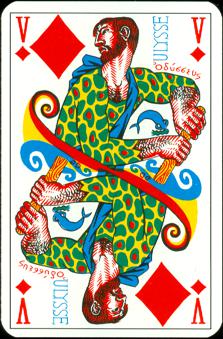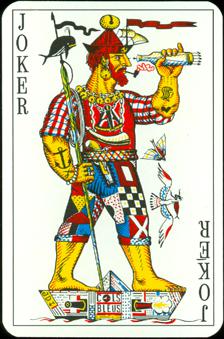December 2014
 |
NO, YOU PROBABLY DON'T HAVE THIS DECK, ALTHOUGH YOU
MAY THINK THAT YOU DO!
Just like
the June 2013 Deck of the Month, the arrival of this deck caused some
confusion. Miriam thought that I had bought it for further trading,
because..... "we already have that one!". It took a few minutes
to find the "Grand Navigateurs" deck and prove her wrong. The
designs look very much alike so |
|
here below
we'll
show you why the mistake was easily made , but first a short word about
the past month. There was only one collectors meeting. This time it was
held on a new location, at the "De Kroon" bar in Kerkdriel, and
the trading room there had a very nice ambiance. We picked up some decks
for trading, but some good decks for our own collection as well. One of
them was the "Carte di Natale" by the Italian artist Pier Canosa.
We already have 2 decks by this artist and had just made contact with an
Italian collector about 2 other ones. This deck was one of them, so by
sheer coincidence we could acquire it before a swap had to be worked out.
The deck was a very close second this month, because it had a |

|
|
very
applicable theme for this month: the birth of baby Jezus. The internet
didn't bring many new decks. We haven't been checking out Ebay very often
and the Dutch auction site only brought an improvement, but nothing new.
So there were not many decks on our short list and the final choice was
made in favor of this deck, because we suspect that some other collectors
may have seen it, but may have made the same mistake as Miriam. We had
never seen this deck before (or maybe we did, but.....) and usually that
means that it is at least a not often seen or maybe even rare deck. And
now we won it at a bargain price. |
The deck
came from the French Ebay and was advertised there as "Beau Jeux de Cartes
Chasseur des Mines Tripartite". The back wasn't shown, just partly some
courts, two aces and the jokers. The deck was designed by Jean Delpech, the same
artist who had designed the "Grand Navigateurs", so there's a definite
similarity in style. But the jokers were the first to give it away. These
weren't the familiar male mermaids (or should we say mermen?) from the Grand
Navigateurs deck and at closer look the aces didn't show any portraits either.
If you want to see why a mistake is easily made, we have prepared a separate
page where we make a comparison between a number of cards from the Grand
Navigateurs deck and the same cards from this deck: click HERE
to go there.
 |

|

|
|
Neptune
and his wife Amphitrite are on the King and Queen of Spades. It's a bit
odd, that the Roman name of Neptune is used here instead of the Greek
Poseidon, while their names are also written in Greek and then Poseidon is
used. Hermes is on the Jack. In the Greek mythology more the God of
travelers than of commerce. |
 |
Jean
Delpech was born in Hanoi on May 1st 1916 and he has started his
artistic education in Indochina at the Ecole des Beaux Arts in Hanoi.
Once in Paris he continued his education at the Ecole des Beaux Arts
there. From 1938 on he had expositions in the Salon des Artistes
Français and from 1946 on in the Salon des Independants. In 1948 he
received the Prix de Rome for his soft pen engravings. In 1956 he was
appointed official artist of the French Navy. This title of "peintre
de la Marine" is given by the Defense Minister to artists who have
dedicated their talents to the sea, the navy or seamen. Being an
official "peintre de la Marine" entitles the artist to embark
on naval ships, to wear a uniform and to add an anchor to his
signature on all his artwork. Although Jean Delpech died in 1988,
expositions of his work carried on until 2004. |
Except for the
Spades, in all other suits the Kings represent the oceans, the Atlantic, Pacific
and Indian Ocean. The Jacks in those suits show heroes from the ancient
Greek mythology. Aeneas (Enée) is a hero from the Trojan wars, Jason is known as one of
the Argonauts and his quest for the Golden Fleece. "Ulysse" on the
Jack of Diamonds is the French name for Odysseus (in Latin Ulixes). He is one of
the most important heroes from the Trojan war as told in Homer's Ilias and later
the main character in Homer's Odyssey. On the card his name is spelled in Greek
as Odysseus. Remarkable is that only Aeneas' name isn't spelled in Greek (JH).
 |
 |
 |

|
|
The aces show different means of propulsion throughout
the ages. We've put the aces in a chronological sequence, starting with
the oar (rame) from a galley, in use since ancient times. On the Ace of
Clubs the sail (voile) is shown in different examples of sailing ships:
from the 14th century Nef (?) to the large ship (vaisseau) of the 17th and
the lugger (lougre) from the 20th century. By the end of the 19th century
steam (vapeur) was used and an example of a war ship (cuirassé) is on the
Ace of Diamonds. The nuclear energy (atome) of the French submarine
Le Redoutable is presented on the Ace of Spades. In French decks
the name of the manufacturer, here B.P. Grimaud, is often mentioned on the Ace
of Clubs. |
 |

|

|
|
The Queens
represent 3 different seas: the Mediterranean sea (on QH) and |
|
 |
the
Arctic Ocean (Mer Boreale) and the Southern Ocean (Mer Australe). |

|
|

|
Each design was
signed by Jean Delpech with J D, sometimes clearly visible, sometimes very
subtle and hidden.
Only on the Jokers he added an anchor to his signature. The deck consists of 52 cards,
2 jokers and 2 extra cards.
The jokers show the naval engineer and the sailor throughout the ages.



There was no box
with our deck, but according to one of the extra cards the deck is titled
"Chasseur des Mines Tripartite". This Tripartite refers to a class of
mine hunters, special ships to locate and destroy mines at sea. The back design
shows 3 of these mine hunters, accompanied by the Dutch, Belgian and French
flag. In 1974 an
agreement was signed by the French, Belgian and Dutch government to develop this
type of ships. The French would provide the mine hunting equipment, the Belgians
the electronic devices and the Dutch would handle the propulsion. France and the
Netherlands would each order 15 ships each and Belgium would take 10. The actual
construction of the mine hunters took place between 1981 and 1989.
The extra cards give a short description of the courts, aces and jokers, but
they also reveal that these cards were probably published as a double deck. The
backs are described as "Constructions navales" and "Navires à la
mer". Our deck has the latter design of "ships at sea".
Apparently the other deck shows a design of "ship building" on the
backs.


Which brings us
to dating the deck. Nowhere in the deck a date is mentioned, so it's a difficult
but somehow interesting question. We've seen that there's a lot of similarity
between this deck and the Grand Navigateurs deck, so it would be nice to
know which has influenced which. We can only think of two possible dates for the
Tripartite deck: to celebrate the agreement to build them (1974) or the launching of
the first ship (1981).
The Grand Navigateurs deck was printed and published by Grimaud in 1976. The
deck was published to honor Eric Tabarly, who in that year had won the OSTAR
(Observer Single-handed Trans-Atlantic Race) solo sailing race for his second
time. His portrait is on the backs.
There's
nothing solid, so we can only suggest possible scenarios:
1/the Tripartite deck
was commissioned by the French Navy to celebrate the agreement in 1974. Maybe
served as gifts for the attending delegates or Navy personnel. It's definitely
not an often seen deck, so most likely from a more limited edition. Because
Grimaud -as printer- had seen the artwork of Delpech it's possible that
Grimaud has contacted Delpech for a commercial edition, the Grand Navigateurs
deck. Tabarly was very popular at that time and this could have attracted more
sales.
2/ The Tripartite deck was commissioned to be presented at the launching of
the first mine hunter in 1981. Delpech adapted the general idea of the Grands
Navigateurs deck somewhat, but did create new designs for this project.
Because of the "ship building" back design we have a slight
preference for the second scenario, but as usual we invite visitors to comment or share additional information. We'll
be happy to add that here. Our deck came in a plastic box, but maybe there's a
French collector who has the deck and the original box, hopefully with a date
or other info on it.
 |
In March
2015 we met Yves Lemain at the Accart meeting in Paris. We spoke briefly
about this deck and he promised to send us scans of the backs.
It's clear that they were designed by Jean Delpech. It's much more his
style than the design of our back and the JD signature is next to the
welder's head.
The DTCN in each corner stands for
Direction Technique Construction Navale. It's part of the large
industrial groupe that is specialized in naval military equipment. The
back design with the DTCN name could mean that the deck was first
published to celebrate the building agreement in 1974. |

|
|
As it's obvious that there have been two
editions, it's likely -based on the design- that our deck comes from the
second edition and was probably published at the launching of the first
mine hunter in 1981. The style of Yves' back designs is thus different
than that of our deck, that it's hard to believe that these are the
"Constructions navales" back that is mentioned on our extra
card. It would be nice if a "sister" of our deck with such a design in a more similar style would turn up. That would complete the
picture. Anyone to show us such a back?
|
BACK TO PRESENT MONTH

























